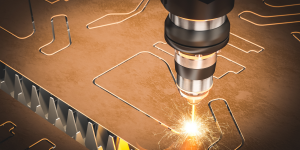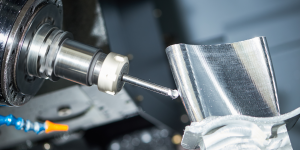Diese Form der CNC -Bearbeitung Kunststoff unterscheidet sich an sich, da man spezifische Kenntnisse und Fähigkeiten benötigt, um optimale Ergebnisse zu erzielen. Entweder sind Sie ein Anfängermaschinist oder ein Experte, aber das Objekt: ist erfolgreich mit Kunststoffmaterialien zu arbeiten, Sie müssen die Komplikationen perfektionieren. Dieser Artikel hebt hervor 8 wertvolle Perlen der Weisheit, die, Wenn der Brief befolgt wird; Würde es Ihnen ermöglichen, Ihren plastischen CNC -Bearbeitungsprozess zu verfeinern. Die Informationen von der Materialauswahl bis hin zu Werkzeugüberlegungen ermöglichen es Ihnen, mit dem wesentlichen Wissen für Genauigkeit und Effizienz der Kunststoffbearbeitung bewaffnet zu werden.
Materialauswahl:
Im Falle von CNC -Bearbeitung von Plastik, Die Materialauswahl ist ein entscheidender Faktor, der sich auswirkt, ob Ihr Maschinenbetrieb erfolgreich ist oder fehlschlägt. Die Kenntnis der Merkmale verschiedener Kunststoffe und deren Anwendung auf spezifische Verwendung ist wichtig. Wärmewiderstand, Chemische Kompatibilität, und dimensionale Stabilität sollte bei der Auswahl des richtigen Kunststoffmaterials für Ihre CNC -Bearbeitungsanwendung berücksichtigt werden. Weiter, Überlegungen wie die Bearbeitbarkeit und die Spezifikationen zur Oberflächenbearbeitung sollten ebenfalls in Betracht gezogen werden, um die besten Ergebnisse zu erzielen. Auswählen des richtigen Kunststoffmaterials für Ihr CNC-Bearbeitung Prozess sorgt für Präzision, Wirksamkeit, und bessere Ergebnisse.

Werkzeugüberlegungen:
In Bezug auf die CNC -Plastikbearbeitung, Werkzeugaspekte spielen eine wesentliche Rolle bei der Erreichung der besten Ergebnisse. Die Auswahl geeigneter Werkzeuge und Schnittparameter hat einen erheblichen Einfluss auf die Qualität und Produktivität der Bearbeitung. Werkzeugmaterial, Werkzeuggeometrie, und Beschichtung sind entscheidende Faktoren für die Ermittlung der Leistung eines bestimmten Tools sowie der Fähigkeit, Qualitätsteile zu produzieren. Auch, Es ist ein Muss zu wissen, was das Kunststoffmaterial für die Bearbeitung benötigt, um die richtigen Werkzeuge und Bearbeitungsmethoden auszuwählen. Durch nachdenkliche Berücksichtigung und Anpassung an die spezifische Natur von Kunststoffmaterial, Maschinisten können die Genauigkeit und Leistung bei der Verwendung von CNC -Maschinen optimieren.
Arbeitsdeliktechniken:
Arbeitsprogrammtechniken spielen eine wichtige Rolle bei der Bearbeitung von CNC -Bearbeitung Kunststoff, da sie die Genauigkeit und Produktivität eines Prozesses direkt beeinflussen. Die Auswahl der richtigen Arbeitsmethoden und -vorrichtungen ist von entscheidender Bedeutung, um die Stabilität sowie die Genauigkeit eines plastischen Teils bei der Bearbeitung zu gewährleisten. Die materiellen Eigenschaften, Teilgeometrie, und die Bearbeitungsvorgänge sollten sorgfältig berücksichtigt werden. Darüber hinaus, Die Bereitstellung der richtigen Klemmkräfte und die Unterstützung von Kunststoffwerkstücken ist von entscheidender Bedeutung, um Vibrationen und Verzerrungen zu vermeiden, die bessere Bearbeitungsergebnisse erzielen werden.
Bearbeitungsparameter:
Die Optimierung der Bearbeitungsparameter ist einer der wichtigsten Punkte, die beim Entwerfen von CNC -Maschinen erwähnt werden können, Arbeiten mit Plastik. Jedoch, Die Auswahl der Schnittgeschwindigkeits -Futterraten, und Tiefen des Schnitts wirken sich stark auf die Qualitätsleistung bearbeiteter Produkte sowie den Prozess der Produktivität aus. Die Auswahl solcher Bearbeitungsparameter wie die besonderen Eigenschaften von Kunststoffmaterial, Werkzeug, und das erwartete Finish erfordert eine eingehende Analyse. Einschließlich mehr, Das Kenntnis der thermischen Eigenschaften und des Chipbildungsverhaltens eines Kunststoffmaterials spielt eine wichtige Rolle bei der Bestimmung optimaler Bearbeitungsparameter, die zu einer minimalen Wärmeerzeugung führen, um genaue Ergebnisse bei der geringsten Werkzeugverschleiß sicherzustellen. Es erfordert häufig nachdenkliche Experimente und Analysen, um die Bearbeitungsparameter für verschiedene Kunststoffmaterialien und eine Teilgeometrie zu bestimmen, was zu einer verbesserten Leistung während der Bearbeitung mit Produkten von besserer Qualität führt.
Kühlung und Schmierung:
Aus der Perspektive der CNC -Bearbeitung von Plastik, Kühlung, und Schmierung wird angewendet, um in verschiedenen Bereichen fortzufahren, um sowohl Qualität als auch Effizienzmechanismen sicherzustellen. Die gesamte Kunststoffbearbeitungsvorgänge erfordert eine effektive Kühlung und Schmierung, um die Wärmeerzeugung zu unterdrücken, Extraktion der Verschleißrate an den Werkzeugschneidungskanten oder der Zahnoberfläche, und sogar eine bessere Chipentfernung zu erkennen. Probleme wie die thermische Leitfähigkeit und Wärmeableitungseigenschaften des Kunststoffmaterials, Zusammen mit spezifischen Schnittparametern müssen bei der Bestimmung geeigneter Kühl- und Schmiermechanismen optimal verstanden werden. Auch, Die Auswahl geeigneter Schneidflüssigkeiten und Kühlmittelabgabemethoden, die mit den Bedürfnissen der Kunststoffbearbeitung kompatibel sind Erhöhte Exposition gegenüber hohen Temperaturen sowie Werkzeugverschleißeffekten hdor., Verbesserung der Leistung in Bezug auf die Bearbeitung Wirksamkeit in Bezug auf die integrierte Teilqualität
Chipkontrolle und Evakuierung:
Fast alles in Bezug, Dies kann als Schlüsselelemente angesehen werden, die die Gesamtgenauigkeitsschwerpunkt bestimmen. Wenn Chips, die sich aus Kunststoffbearbeitungsverfahren ergeben, nicht gut verwaltet werden, Probleme wie das Wiederieren des Schneidwerkzeugs verursachen Probleme wie Chip zur Bildung von Kanten und Schäden an Werkzeugen können vorherrschend sein. Berücksichtigung von Themen wie der Natur, Geometrie, und andere Merkmale, die mit verwendeten Kunststoffmaterialien verbunden sind, sowie Effekten Schneidenparameter einschließlich Werkzeuggeometrien spielen eine wichtige Rolle bei der Gewährleistung einer optimalen Chipsteuerung.
Anforderungen an die Oberfläche:
Es erfordert viel Kenntnis von Faktoren, die die Oberflächenqualität und die Anwendung der richtigen Techniken beeinflussen, um das erforderliche Finish in CNC -Bearbeitung Kunststoff zu erreichen. Die Anforderungen an die Oberflächenbeschaffung für Kunststoffteile können sich auf der Zielanwendung unterscheiden, Materialeigenschaften, und Entwurfspezifikationen. Werkzeuggeometrie, Schneidenparameter, und Kühl-/Schmierentechniken spielen auch eine wichtige Rolle bei der Entscheidung des Oberflächenfinish von bearbeiteten Kunststoffteilen. Außerdem, Die Auswahl der richtigen Bearbeitungsstrategien zum Beispiel klettern Mahlen oder herkömmliches Mahlen. Durch sorgfältige Aufmerksamkeit auf die Spezifikationen der Oberflächenbearbeitung und genaue Anpassungen von Bearbeitungsprozessen gemäß bestimmten Kriterien, Kunststoffkomponenten können hergestellt werden, die den erforderlichen Eigenschaften erfüllen.

Überlegungen nach der Herstellung:
Die Überlegungen nach der Herstellung sind für CNC-bearbeitete Kunststoff von größter Bedeutung, da die Qualität und Leistung der endgültigen Teile von ihnen abhängt. Sobald der Bearbeitungsvorgang abgeschlossen ist, Es ist notwendig, die dimensionale Toleranz zu bewerten, Oberflächen -Finish -Status, und allgemeine Teilqualität, um sicherzustellen, dass alle Spezifikationen erfüllt werden. Außerdem, Post-Bearbeitungsinspektionen und Qualitätskontrolle sollte durchgeführt werden, um mögliche Defekte oder Abweichungen von den Spezifikationen zu identifizieren. Zusätzlich, Unter Berücksichtigung der erforderlichen Nachbearbeitungsprozessverfahren wie dem Entlösen, Reinigung, oder Oberflächenbehandlungen sind obligatorisch, um die bearbeiteten Kunststoffteile für ihre endgültige Anwendung vorzubereiten. Durch fleißige Überlegungen nach Nachbedenken nach der Herstellung, Maschinisten können die Einhaltung der Präzisions- und Qualitätsstandards in ihren CNC -Bearbeitungsvorgängen sicherstellen.
Abschluss
CNC -Bearbeitung Kunststoff beinhaltet besondere Überlegungen und Probleme, die im Detail einschließlich Materialeigenschaften verstanden werden müssen, Werkzeugaspekte, Bearbeitungsparameter sowie Nachbearbeitungstechniken. Mit dem 8 In diesem Beitrag diskutierte wichtige Wissensnuggets, Maschinisten können ihre Kunststoffbearbeitungsverfahren fein abstellen, um Teile mit großer Qualität und Effizienz mit großer Qualität zu erhalten. Angesichts seiner Betonung der Genauigkeit und des Details, Die Perfektionierung der Fähigkeiten der CNC -Bearbeitung von Kunststoff kann zu hervorragenden Ergebnissen und erhöhten Fertigungsfähigkeiten führen.
